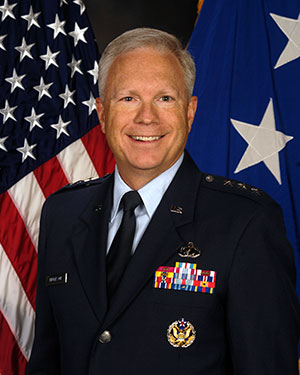SMC commander Lt. Gen. Thompson retires
Lt. Gen. John F. Thompson, commander of the Space and Missile Systems Center (SMC), will retire Aug. 1. A ceremony celebrating his career and achievements took place July 27 at Los Angeles Air Force Base, California, where SMC is based.
Thompson, who is the longest serving three-star commander for SMC, retires after a 36-year career with the U.S. Air Force, having served in various roles leading defense acquisition programs, strategic systems and lifecycle management.
Brig. Gen. D. Jason Cothern, current vice commander of SMC, will serve as the SMC commander while the center awaits a confirmation of a three-star general officer.
SMC includes the positioning, navigation and timing (PNT) mission, in which professionals acquire, deliver and sustain reliable GPS capabilities to America’s warfighters, allies and civil users.
“Lt. Gen. Thompson’s exemplary career has made the nation safer, stronger and better secured against an increasingly contested space environment, and earned the well-deserved opportunity to enjoy this next chapter in his life,” stated a press release from SMC.
As the commander of SMC, he led more than 6,300 military, government service and contract employees nationwide, and oversaw an annual budget of $9 billion, which accounts for 85 percent of the nation’s space budget.
In the past 18 months, Lt. Gen. Thompson tirelessly led the groundwork for the stand-up of the U.S. Space Force’s newest Field Command, Space Systems Command, which will lead the Force in the development, delivery and acquisition of innovative space warfighting capabilities.
Having completed his four-year tour as the SMC commander, his retirement will not affect the timeline of the SSC stand-up — a complex process requiring activities and approvals at the highest levels before implementation.























Tracy, Your article about General Thompson’s retirement brought back memories of a 2nd Lt, just graduated from Purdue, beginning his Air Force career at Norton AFB in the Advanced Plans Office of the Ballistic Systems Division (BSD) of the Air Force Systems Command. Later BSD combined with the Space Systems Division to become the Space and Missile Systems Organization (SAMSO). I left the Air Force after a tour as a Squadron Commander in Thailand (don’t ask, I was married to a WAF at the time who ended up being transferred to Thailand and I applied to follow her.) I’m certain that none of the systems I spent so much effort evaluating in the late ’60s are more than relics stored away in an Air Force museum.
In closing I thank you for the interesting articles you have written these past fifteen years and wish you prosperity and good health in the future. Clint Bowman